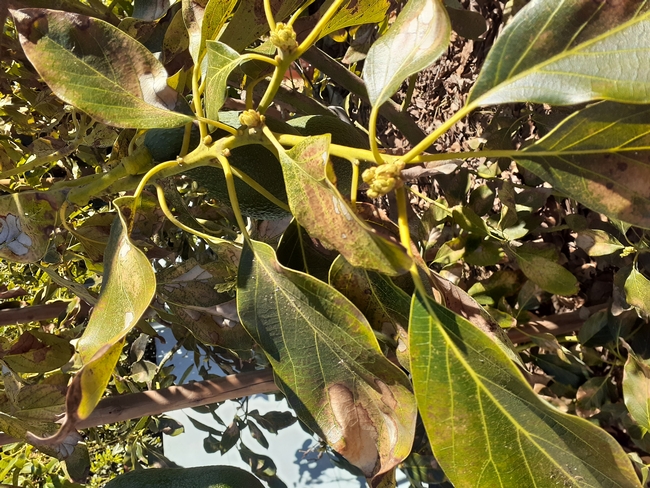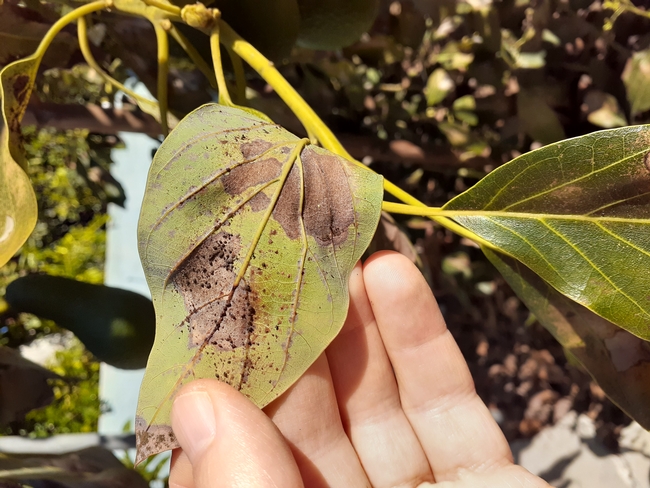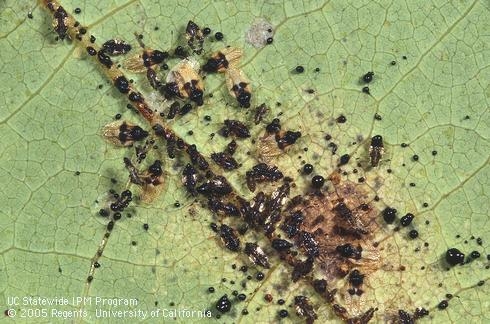Posts Tagged: avocado lace bug
Avocado Lace Bug Spreads
There has been a recent expansion of Avocado Lace Bug into parts of the Carpinteria area. It was more or less located in the San Diego coastal area. It spreads mainly with people.......
Read about it at the UC-IPM website and the observations of Mark Hoddle, IPM Specialist at UC Riverside.
https://ipm.ucanr.edu/agriculture/avocado/avocado-lace-bug/#gsc.tab=0
- ALB does better in the slightly cooler more humid orchards in Oceanside when compared to the hotter inland Bonsall orchards.
- In the lab, under a fluctuating 24 hr temperate cycle similar to an avocado orchard in Escondido, optimal temps for development are a daily average of around 31-32oC (88-90oF)
- ALB life stage densities tend to be greater on leaves over June-Oct
- % leaf infestation measures (i.e., the proportion of sampled leaves with ALB lifestages) tend to be peak over fall-winter (Sept-Feb), but ALB densities on leaves are not as high as what are seen over June-Oct, there are basically more leaves with ALB and those per leaf densities are lower that numbers counted over June-Oct.
- Its hard to predict what the next season's ALB will be as lots of ALB are shed when leaves drop, but like persea mite, some manage to get back onto the new leaves to start the next round of infestations. Adults don't seem to be very flighty, well, at least they don't seem to exhibit mass flight activity that would suggest searching for new hosts as leaves deteriorate.
Keep your eyes open for a future edition of the CA Avocado Commission's magazine - From The Grove - for a more thorough discussion of the pest.
https://www.californiaavocadogrowers.com/publications/from-the-grove
images:
Adult
Adults, young, and fecal pellets
Leaf damage
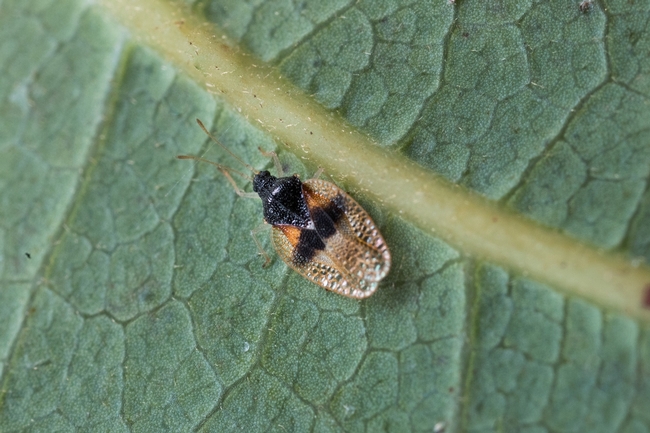
ALB-Low-Res

avocado lace bug
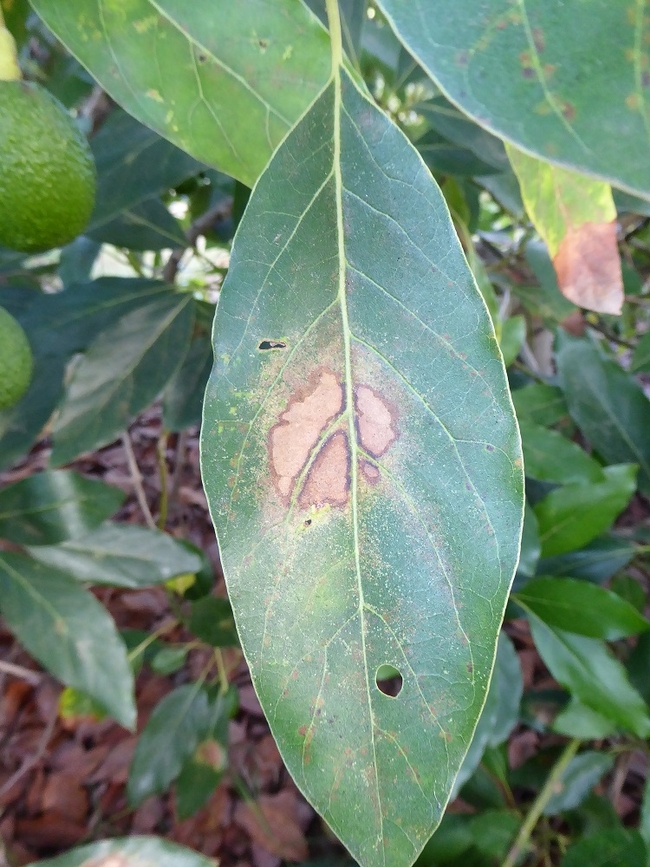
ALB-Leaf-Damage-Low-Res
Lawn-pocalypse! Surviving Drought
Ah, summer! The season of sunburns, pool parties, and… lawn droughts. If your once lush, green carpet now looks like a crunchy brown doormat, you're not alone. Let's dive into why your yard is staging a dramatic death scene and what you can do to...

Bermuda grass and weeds overtaking drought stressed turf grass.
Climate-Change Resources
University of California UC ANR Green Blog (Climate Change and Other Topics) https://ucanr.edu/blogs/Green/index.cfm?tagname=climate%20change (full index)
Examples:
- Save Trees First: Tips to Keep Them Alive Under Drought https://ucanr.edu/b/~CdD
- Landscaping with Fire Exposure in Mind: https://ucanr.edu/b/~G4D
- Cities in California Inland Areas Must Make Street Tree Changes to adapt to Future Climate https://ucanr.edu/b/~oF7
Drought, Climate Change and California Water Management Ted Grantham, UC Cooperative Extension specialist (23 minutes) https://youtu.be/dlimj75Wn9Q
Climate Variability and Change: Trends and Impacts on CA Agriculture Tapan Pathak, UC Cooperative Extension specialist (24 minutes) https://youtu.be/bIHI0yqqQJc
California Institute for Water Resources (links to blogs, talks, podcasts, water experts, etc.) https://ciwr.ucanr.edu/California_Drought_Expertise/
UC ANR Wildfire Resources (publications, videos, etc.) https://ucanr.edu/News/For_the_media/Press_kits/Wildfire/ (main website)
-UC ANR Fire Resources and Information https://ucanr.edu/sites/fire/ (main website)
-Preparing Home Landscaping https://ucanr.edu/sites/fire/Prepare/Landscaping/
UC ANR Free Publications https://anrcatalog.ucanr.edu/ (main website)
- Benefits of Plants to Humans and Urban Ecosystems: https://anrcatalog.ucanr.edu/pdf/8726.pdf
-Keeping Plants Alive Under Drought and Water Restrictions (English version) https://anrcatalog.ucanr.edu/pdf/8553.pdf
(Spanish version) https://anrcatalog.ucanr.edu/pdf/8628.pdf
- Use of Graywater in Urban Landscapes https://anrcatalog.ucanr.edu/pdf/8536.pdf
- Sustainable Landscaping in California https://anrcatalog.ucanr.edu/pdf/8504.pdf
Other (Non-UC) Climate Change Resources
Urban Forests and Climate Change. Urban forests play an important role in climate change mitigation and adaptation. Active stewardship of a community's forestry assets can strengthen local resilience to climate change while creating more sustainable and desirable places to live. https://www.fs.usda.gov/ccrc/topics/urban-forests
Examining the Viability of Planting Trees to Mitigate Climate Change (plausible at the forest level) https://climate.nasa.gov/news/2927/examining-the-viability-of-planting-trees-to-help-mitigate-climate-change/
Reports and other information resources coordinated under the auspices of the United Nations and produced through the collaboration of thousands of international scientists to provide a clear and up to date view of the current state of scientific knowledge relevant to climate change. United Nations Climate Action
Scientific reports, programs, action movements and events related to climate change. National Center for Atmospheric Research (National Science Foundation)
Find useful reports, program information and other documents resulting from federally funded research and development into the behavior of the atmosphere and related physical, biological and social systems. Search and find climate data from prehistory through to an hour ago in the world's largest climate data archive. (Formerly the "Climatic Data Center") National Centers for Environmental Information (NOAA)
Think tank providing information, analysis, policy and solution development for addressing climate change and energy issues (formerly known as the: "Pew Center on Global Climate Change"). Center for Climate & Energy Solutions (C2ES)
Mapping Resilience: A Blueprint for Thriving in the Face of Climate Disaster. The Climate Adaptation Knowledge Exchange (CAKE) was launched in July 2010 and is managed by EcoAdapt, a non-profit with a singular mission: to create a robust future in the face of climate change by bringing together diverse players to reshape planning and management in response to rapid climate change. https://www.cakex.org/documents/mapping-resilience-blueprint-thriving-face-climate-disaster
Cal-Adapt provides a way to explore peer-reviewed data that portrays how climate change might affect California at the state and local level. We make this data available through downloads, visualizations, and the Cal-Adapt API for your research, outreach, and adaptation planning needs. Cal-Adapt is a collaboration between state agency funding programs, university and private sector researchers https://cal-adapt.org/
Find reports, maps, data and other resources produced through a confederation of the research arms of 13 Federal departments and agencies that carry out research and develop and maintain capabilities that support the Nation's response to global change. Global Change (U.S. Global Change Research Program)
The Pacific Institute is a global water think tank that combines science-based thought leadership with active outreach to influence local, national, and international efforts to develop sustainable water policies. https://pacinst.org/our-approach/
Making equity real in climate adaptation and community resilience policies and programs: a guidebook. https://greenlining.org/publications/2019/making-equity-real-in-climate-adaption-and-community-resilience-policies-and-programs-a-guidebook/
Quarterly CA Climate Updates and CA Drought Monitor Maps (updated each Thursday) https://www.drought.gov/documents/quarterly-climate-impacts-and-outlook-western-region-june-2022
Drought focus of Water Resources IMPACT magazine special issue
UC ANR experts address emotional toll of drought
Preparing the American West for prolonged drought is the focus of a double issue of Water Resources IMPACT magazine. The California Water Commission staff are guest editors for this special open-access edition of the magazine, which is published by the American Water Resources Association.
Faith Kearns, academic coordinator of University of California Agriculture and Natural Resources' California Institute for Water Resources, is among the authors delving into how drought impacts people and the environment and how we can better prepare for the inevitable.
The first issue, published on Feb. 14, focuses on water scarcity issues confronting California and the ways these issues affect different sectors.
In “Trauma, Care, and Solidarity: Addressing the Emotional Toll of Chronic Drought,” Kearns highlights the effects of drought on mental health. She points to the spike in suicide hotline calls when wells ran dry in Southeast Asian communities in California's Central Valley.
By listening to Southeast Asian farmers, Ruth Dahlquist-Willard and Michael Yang of UC Cooperative Extension were able to “lighten the load” for them by providing pragmatic support, Kearns writes.
“The scale of some of these highly emotional issues – drought, wildfires, climate change – can make them seem incredibly difficult, if not impossible, to deal with,” Kearns said. “At the same time, they are affecting everyone living in the western U.S. on a daily basis. I wanted to highlight and provide models based on work that people – whether they are researchers, clinical psychologists, or Cooperative Extension advisors – are doing right now to ease the way.”
The authors who contributed to the double issue are a diverse array of Tribal experts, academics, nongovernmental organization thought-leaders, water managers and water policy influencers, each of whom brings their own perspective on the topic of drought. Their expertise and perspectives in climate science, water policy and water management will help inform drought-related decision-making and support policies that better prepare the state to thrive during periods of prolonged water scarcity.
In addition to Kearns, the first issue includes articles contributed by:
- Samantha Stevenson, University of California, Santa Barbara
- Jay Lund, University of California, Davis
- Ron Goode, North Fork Mono Tribe
- Andy Fecko, Placer County Water Agency
- Jeff Mount, Public Policy Institute of California, and Ted Grantham, University of California, Berkeley/UC Cooperative Extension
- Nat Seavy and Karyn Stockdale, National Audubon Society
- Kjia Rivers, Community Water Center
- Cannon Michael, Bowles Farming
- Michelle Reimers, Turlock Irrigation District
The January/February edition of Water Resources IMPACT magazine can be accessed, free of charge, on the American Water Resources Association website at https://www.awra.org under “Publications.”
The second issue, to be published in March, will focus on drought response, considering the options for adaptation. This two-part series complements the Commission's work on strategies to protect communities and fish and wildlife in the event of a long-term drought.
ALB is Spreading
In 2004, Avocado Lace Bug was identified in backyard trees in Chula Vista and National City in San Diego County, probably originating from Mexico. Later in 2017, ALB was being picked up in the Oceanside, Fallbrook, and Temecula areas apparently originating from more Caribbean/Florida sources. That year, it also showed up in Long Beach and Culver City, and of the Mexican origin like in Chula Vista. Then in 2021, it showed up in Carpinteria, previously causing some major issues in Oahu, Hawaii that same year.
There has been some infill in the California infestations along the way, but it has not appeared to be as aggressive a spreader as persea mite or avocado thrips. Recently it was identified at a new site in Orange County. Mark Hoddle's lab at UC Riverside is following the spread and has helped in identifying where the infestations have been originating through DNA analysis.
Identification of ALB is quite easy since there are no other pests in California that it can be easily confused with. The first thing that usually draws your attention when looking for ALB is “islands” on the leaves. These necrotic regions develop because of the ALB adults feeding on the underside of the leaves and sucking the leaf juices from between the upper and lower leaf surfaces.
When the leaf is turned over, the adults, although only about 2 mm in length, are easily seen with the naked eye. Adults are oval, appear yellow to pale orange, and have dark heads. Nymphs are smaller than adults, oblong and are black, dark brown or reddish colored depending on their stage of development. Eggs appear as small black dots of varying sizes. What is visible is a dark sticky secretion covering the egg to protect it from predation. Under the sticky secretion, the eggs are oblong and yellowish.
Keep your eyes open for the damage and the pest, they are quite distinctive. The earlier it can be treated, the better the eventual control.




